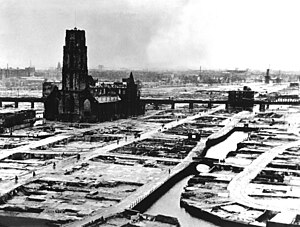| German invasion of the Netherlands | |||||||
|---|---|---|---|---|---|---|---|
| Part of the Battle of France | |||||||
 The centre of Rotterdam destroyed after being bombed by the Luftwaffe | |||||||
| |||||||
| Belligerents | |||||||
|
| |||||||
| Commanders and leaders | |||||||
| Strength | |||||||
|
280,000 men (Dutch only) (9 divisions) 700 guns[1] 1 tank 5 tankettes 32 armoured cars[2] 145 aircraft[3] |
750,000 men (22 divisions) 1,378 guns 759 tanks 830 aircraft[4] 6 armoured trains[5] | ||||||
| Casualties and losses | |||||||
|
|
| ||||||
| 2,000+ civilians killed[6] | |||||||
The German invasion of the Netherlands (Dutch: Duitse aanval op Nederland), otherwise known as the Battle of the Netherlands (Dutch: Slag om Nederland), was a military campaign, part of Case Yellow (German: Fall Gelb), the Nazi German invasion of the Low Countries (Belgium, Luxembourg, and the Netherlands) and France during World War II. The battle lasted from 10 May 1940 until the surrender of the main Dutch forces on 14 May. Dutch troops in the province of Zealand continued to resist the Wehrmacht until 17 May, when Germany completed its occupation of the whole country.
The invasion of the Netherlands saw some of the earliest mass paratroop drops, to occupy tactical points and assist the advance of ground troops. The German Luftwaffe used paratroopers in the capture of several airfields in the vicinity of Rotterdam and The Hague, helping to quickly overrun the country and immobilise Dutch forces.
After the devastating Nazi bombing of Rotterdam by the Luftwaffe on 14 May, the Germans threatened to bomb other Dutch cities if the Dutch forces refused to surrender. The General Staff knew it could not stop the bombers, and ordered the Royal Netherlands Army to cease hostilities. The last occupied parts of the Netherlands were liberated in 1945.
- ^ Goossens, Dutch armament: Artillery, waroverholland.nl Archived 15 August 2017 at the Wayback Machine
- ^ Goossens, Dutch armament: Miscellaneous, waroverholland.nl Archived 22 October 2020 at the Wayback Machine
- ^ Goossens, Dutch armament: Military airplanes, waroverholland.nl Archived 19 September 2020 at the Wayback Machine
- ^ Hooton 2007, p. 48
- ^ De Jong, Het Koninkrijk, Staatsuitgeverij, 1971
- ^ a b c d e f g h i Goossens, Balance Sheet, waroverholland.nl Archived 17 September 2011 at the Wayback Machine
- ^ Kaufmann, J.E.; Kaufmann, H.W. (2007). Hitler's Blitzkrieg Campaigns: The Invasion And Defense Of Western Europe, 1939–1940. Da Capo Press. p. 191. ISBN 9780306816918.[permanent dead link]